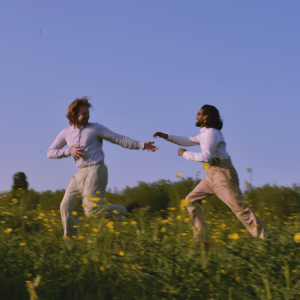
A Life of Grime
by Samuel Ilyas | December 9, 2016
‘Without this shit I be losing my mind (…)
So much more than drugs and violence
it’s young black kids refusing to cry.’
– J-mal, A Life of Grime (2016)
It’s dark in the studio. The room sits just above a railway line on the outskirts of Stratford, and Sam, the sound engineer, insists we close the shutters as well as the windows to keep out the noise of passing trains below. A dim orange lamp in the corner provides the only light. The carpet is decorated with a selection of miscellaneous recording equipment, some of it dating from as far back as the sixties.
By the workstation, J-mal, a young MC from North London, is sitting with the sound engineer. He’s trying to explain what needs tweaking, a difficult job for a man with clear vision but limited technical vocabulary. Dusty, also an MC and J-mal’s partner in grime, sits on the bed, pad in hand, scribbling frantically and muttering under his breath. His hands make minute movements, scaled down to fit the volume of his verse. When J-mal is finally content with the mix he throws on his headphones and steps in the ‘booth’, little more than a microphone surrounded by various soundproofing implements.
“I’m ready, roll the beat,” he says.
The beat drops, and he lays into it like a man possessed.
Grime is performance art. It emerged out of London’s garage and jungle scenes in the early 2000s and was sculpted into its own standout genre in the underground raves of the capital’s East End. Combining a diverse range of influences like dancehall and hip-hop, with fast paced vocals and simple drum loops, the energy of its delivery is an integral to the genre. Regardless of whether it is being performed on a crowded stage before a sea of ecstatic ravers, or in a dark student flat with a single standing mic, it comes with the same manic energy. “The first time [I] put words to the page, [I was] just a twelve year old trying to come to terms with his pain.” J-mal says in one of his lyrics. The way he performs the track, spitting through gritted teeth, stamping his feet and shaking his head vigorously to the extent that Dusty has to stop himself from wailing out and ruining the take, it is clear that, for those involved, grime is much more than just a style of music. There is something spiritual in the air, a violent force which seems to physically occupy the two artists as the music washes over them. This is what it means to live Grime.
Three weeks later, J-mal and Dusty started shooting the music video in an old estate in West London, a battered collection of buildings that has been reclaimed by street artists and young creatives in recent years. In many ways it is oddly emblematic of grime as a genre—a rundown, working class establishment that has suddenly become fashionable within student and hipster communities, finding itself caught between two very different worlds. No longer the preserve of dedicated grime-kids, the genre has gained ground among previously untapped audiences, moving from the peripheral to the mainstream of the UK’s music scene. The origins of the style are firmly rooted in London’s underserved black communities, where grime acted as an outlet for the frustration many young black men and women felt about their environment and position within society. The genre’s growing popularity among the white middle classes raises concerns about the distorting effect of the genre’s expansion, with the mainstream potentially dragging grime away from its underground roots.
Speaking to Wowa, an established videographer who recently filmed the video for grime legend Wiley’s new single ‘Can’t go Wrong‘, I get the sense that for the scene’s originals, the genre has lost its way. “A lot of it feels too polished to me now. I even like the old mixdowns you know,” he chuckles when asked what he thinks about the current state of the scene. Both he and J-mal agree that the new generation of Grime MCs lack the kind of raw talent possessed by the up-and-comers of the late 2000s, when original artists like Maxsta, Axeman (now Aks) and Scruface (now Scrufizzer) rose to grime-star status.
“It’s not that people aren’t good anymore. It just feels a lot more gimmicky. Like it’s more about one-liners that people can sing along to than it is about quality lyricism,” he continues. The miseducation of the genre’s current listening base does not appear to be helping the problem.
Grime artists have ventured into the world of mainstream music in the past, but until recently, there was always a clear divide between their grime corpus and their more commercial songs. Tracks like Chipmunk’s ‘Oopsy Daisy’, Wiley’s ‘Wearing my Rolex’ or Tinchy Strider and Ndubz’s ‘Number One’ were not grime songs; they were pop songs by grime artists. Now, as the genre’s popularity grows, it seems the influence of outside tastes is penetrating deeper into the fabric of grime music than ever before, and the resultant change in grime is obvious.
“Trap music’s helped a lot,” J-mal tells me, leaning forward so as to be heard over the noise of the train, “now people are sort of used to hearing vocals over 140bpm, so Grime doesn’t sound so mad. Really a lot of Grime now is basically just trap with an English accent, guys like Section Boyz, even a lot of Chip’s tracks are done over trap beats.’”
Thanks to its expanded audience, grime is now a commercially viable business, offering an abundance of new opportunities for the scene to grow and develop. Nevertheless Dusty, J-mal, and Wowa all talk fondly about the days when there was little money in grime, before Stormzy won a MOBO and Sketpa took home a Mercury. Once, it was all about a love for the music and its culture. Now, they say, people just want to get paid. Wowa stands out in this regard. Despite being one of the most respected and highly sought after videographers in the scene, he still charges a fraction of what many of his contemporaries do, works only with artists he respects. “I don’t really do it for the money,” he tells me. “At the end of the day, you never know who’s gonna blow, and if I can help put someone on…” He trails off and smiles.
Wowa’s latest clients are making some headway. J-mal was recently featured on the popular DJ Charlie Sloth’s Fire in the Streets video series. Dusty has been recognised by Jamal Edwards of SBTV and, if he can negotiate around the new upload charge for the grime website, is set to appear on the channel in the near future. Perhaps the duo will be among the few that make it. Grime’s popularity isn’t likely to dwindle any time soon, and now more than ever, there seems be space in the pantheon for fresh voices. The talent is there, the hunger is real. The rest is for the gods of grime to decide.




